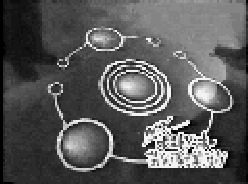JOURNAL OF THE FELLOWSHIP OF QUAKERS IN THE ARTS
Issue #8, Winter 1997-98
“Virtual Morality”: A Quaker in Cyberspace

an interview with Ebon Fisher
by Esther Mürer
Right: Bionic Code: "Bypass Elitist Node." Fuji Television, "Oh My NY!" — a live broadcast by satellite from Galapagos Artspace in Williamsburg, Brooklyn, to 10 million Japanese TV viewers. September 1997.
You won’t find meme breeders among the categories of artists listed on the new FQA brochure. No matter. God willing, there will always be artists who are led to explore new paths, even to invent media for which we as yet have no words.
Ebon Fisher is, among other things, a meme breeder. Born in 1959, he was raised a Quaker, and is a member of Germantown MM in Philadelphia. He holds a master’s from MIT, where he worked in the Media Lab until he decided he wanted to foster the interactivity of people, not just computers. He now has a studio, Nerve Circle Creations, in the Williamsburg section of Brooklyn, NY.
Ebon has long been fascinated with biotechnology, which he sees as a model for cultural evolution. In the early 1980s he began experimenting transfering biological language and symbols into a wider cultural context. Spray-painting stylized brain cells on bridges, golf courses, and abandoned cars was the first of many attempts to remove biological language from its scientific context.
More recently he has devised a series of media organisms (memes) which he calls bionic codes. “I am not interested in simulating nature,” Ebon says, “but in incubating bio-technological processes in an actual media culture. I want to grow things in a petri dish of living communications.”
The bionic codes are computer-generated images which he has disseminated in such diverse media as stickers, T-shirts, nightclubs, installations in museums, the internet, and happenings (“web jams”) and an interactive multimedia environment (“the AlulA Dimension”). It is Ebon’s hope that the memes will reproduce themselves, mutating to adapt to different media to create a sort of “virtual morality.”
Ebon prefers “media” to “art” as an umbrella word for a democratic, inclusive sphere of activity. Both the art world and pop culture take art out of its cultural context--the former by focusing in the artistic expression of the individual, the latter by focusing on the desires of the consumer. In both cases art is divorced from its social functions. Ebon wants to find a third way which involves mutual nurturing of whole systems of socio-ecological organisms.
Ebon sees his projects as Quakerism in action. He says that Quakers are too hung up on print to the exclusion of other media. He is trying to translate Quaker spirituality and testimonies into logos, simple symbols which will cut through media noise and per meate the subconscious of our culture. He pointed out that most of the codes are circular in design, like a Quaker meeting for worship. “The void is a strategic part of Quaker social experience,” he says. “People use their own bodies as a transmitter, the whole group is creating transmissions.”
The bionic codes are part of a a broader, evolving philosophy of “nurturing the fluid, dynamic liveliness which might be described as Spirit.” Ebon calls this philosophy “Wigglism.” ( I can’t begin to do justice to Wigglism here, but some of its flavor is shown in the box following this article .):
Like many of us, Ebon struggles with a feeling that Friends don’t perceive the link between his Quakerism and his art. At times his Quaker upbringing surfaces as “....a bizarre sense of failure for having dedicated my life to the pursuit of ephemera, and not wholeheartedly of explicit social change. I can intellectualize to myself that what I do does count politically in an indirect sort of way, but there is always that nagging sense that I am enjoying myself too much! The hedonism inherent in being in touch with my feelings--a necessary mechanism for mediating between audience, medium, and content-- seems somehow threatening, or even worse, frivolous, to certain Quakers.
“They don’t always take contemporary artists seriously. Only the classical ‘top 40’ are sufficiently preppy. It makes me feel invisible, inconsequential, in the Quaker sphere. However Japanese Television and the Guggenheim Museum Magazine have been very perky. Does that mean I’m becoming Buddhist or Lutheran?! No, of course not. But it does secularize me. I'm extremely fond of my Quaker roots, however, and still consider myself a Quaker in the most elemental sense.
But then, he reflects, “perhaps the Quakers are no different from other traditional religious groups. The Arts can be seen as a threatening, emerging religious order with its own set of priests (artists, writers, musicians, filmmakers), bishops (curators), and houses of worship (galleries, nightclubs, cafés, museums). There are, however, interesting cross-references between philosophies of creation and older religious orders. The artist-as-genius mold can be traced to priest-oriented religions. Everyone-is-an-artist movements such as Dada, Fluxus, and ecstatic nightclub dancing scenarios (including jazz, the blues, folk-rock, grunge, and rave) have evident links in my mind to the Quakers and other egalitarian movements. It’s too bad the Quaker influence on culture cannot be more strongly present as [is] its influence on non-violence, social service, and environmental issues.”
Different facets of Ebon Fisher’s work may be seen on the web at the following sites:
THE ALULA DIMENSION
AlulA, Bionic codes, Media rituals
Types & Shadows is published quarterly by the Fellowship of Quakers in the Arts. Subscriptions are available through membership in the FQA.
T&S Archive | FQA Home Page | Join FQA
This page revised July 2001